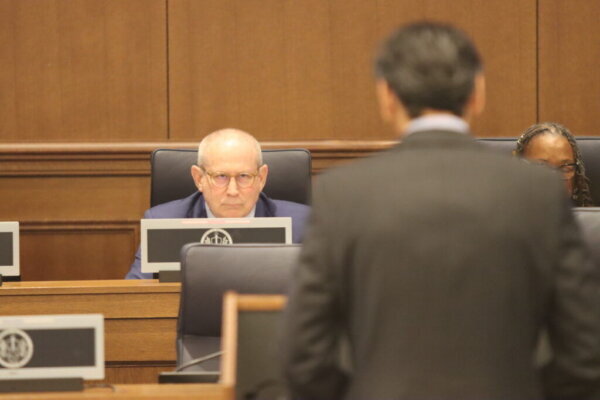This article was reprinted with permission from Virginia Mercury.

Officials from Virginia Commonwealth University and VCU Health System told lawmakers on Wednesday they are reviewing an agreement to pay the city of Richmond approximately $2.5 million annually in lieu of taxes for a development that was never built, after the school paid the city, investors and developers nearly $80 million to exit the failed building project.
In 2021, VCU Health System signed a lease with a developer to construct the Clay Street Project, which included a medical tower, office and retail space and parking on the site of Richmond’s former Public Safety Building at Clay and 10th Streets. At the time, VCU agreed to pay the city a total of $56 million in lieu of taxes for the $325 million project, which was to be paid out in increments of $2.5 million annually, according to the Richmond Times-Dispatch.
However, a year later the partnership ended after the developer and the health system could not agree to terms on the budget due to unsuitable site conditions and increased construction costs. As part of the health system’s plan to cancel the project, it paid $80 million, but the annual $2.5 million payments to the city in lieu of taxes continued. Now, lawmakers and VCU Health leaders are questioning and investigating whether the annual payments are legal.
VCU’s health system was directed to terminate the payments, according to language included in the recently approved state biennium budget. Under that measure, the health system must provide a report to the legislature on the status of that decision by Oct. 1.
“Speaking in the past tense, I think at the time that this was agreed to, it was felt to be correct to do that; in the present tense, that’s being reviewed and why we are currently in conversations with the city about that very topic,” said Marlon Levy, interim CEO of VCU Health System.
According to the Joint Legislative Audit and Review Commission, which conducts analysis and provides oversight of state agencies on behalf of the General Assembly, VCU Health has made at least one $2.5 million payment to the city.
Petula Burks, a spokeswoman for the city of Richmond, said in a statement: “The city believes the guaranteed obligation agreed to by VCUHS needs to be honored. It is a contractual requirement entered into by VCUHS of their own volition.”
Sen. Jeremy McPike, D-Prince William, said, however, “you can’t tax something that doesn’t exist,” throwing in his support for officials to review the agreement.
“[VCU] has no controlling interest at this point,” McPike said. “The only way to pass through IRS tax exemption to a leasehold is to have an actionable operation of a leased facility or a component of [one], of which it has none.”
Last year, lawmakers directed researchers to conduct the study and review the health system’s response to the Clay Street Project.
Officials from VCU addressed lawmakers following a presentation by the Joint Legislative Audit and Review Commission, which reviewed the roles and responsibilities of the VCU Health System’s Board of Directors, the system’s governance structure, and the capital procurement process.
Hal Greer, staff director for JLARC, said the report only focuses on the findings and recommendations to improve VCU’s capital processing infrastructure. No recommendations were made regarding the Clay Street Project.
VCU President Michael Rao, who also serves as the health system’s president, said on Wednesday that acquiring the property was important for the system’s future in 2021. But the project became “impossible” with national economic pressures such as inflation intensifying during the pandemic.

Researchers said VCU Health had improved its capital process by hiring outside consultants and revising its capital project process. Still, they said, more work is needed to develop a long-term strategic capital plan, strengthen several policies, and increase staffing to handle capital projects that can sustain and expand the system’s operations effectively.
Two key recommendations included eliminating the health system president position and creating two separate positions, VCU Health System CEO and VCU SVP of health sciences, roles that are currently combined.
Both recommendations would require changes to the Code of Virginia.
Researchers recommended the president’s position be eliminated because it’s a conflict of interest. The health system president is also the university president.
Board members told the research team that they believe the university president should not be the board chair, should not be able to vote, and supported eliminating the position. According to JLARC staff, the president has the authority to evaluate the performance of the health system CEO and recommend compensation for that person, and can schedule executive committee meetings and modify the order of business for the Board of Directors.
Rao said he supports the idea of the position being eliminated.
“These are roles that a lot of my colleagues, regardless of the structure around the nation, do not share with me,” Rao said, adding that it can be confusing.
JLARC staff also recommended that the health system’s board members have longer terms, possess expertise in additional topics relevant to health system governance, and be impartial.
VCU officials said after the presentation that plans to address JLARC’s recommendations are underway.
Editor’s note: This story has been updated with remarks from the city of Richmond.








